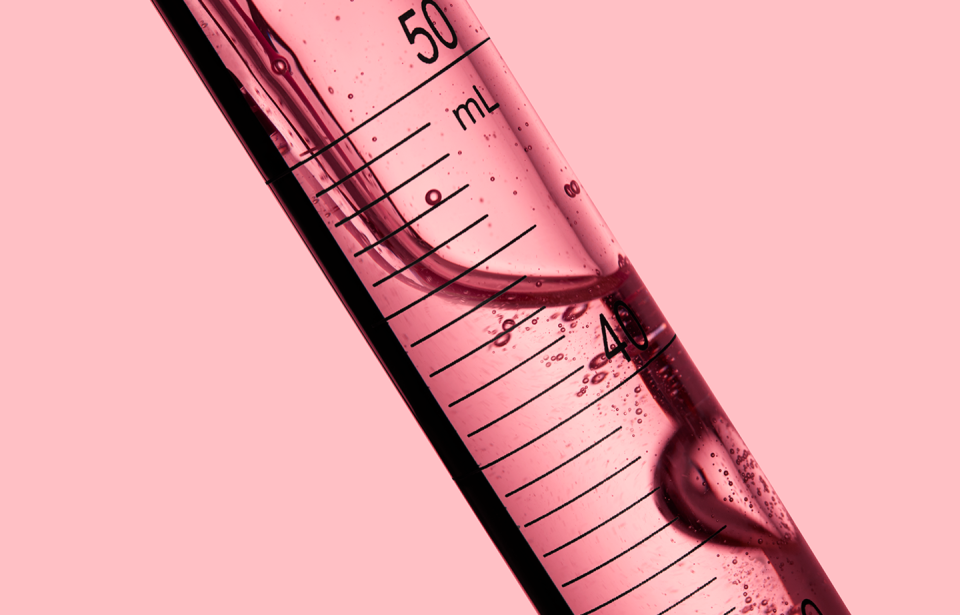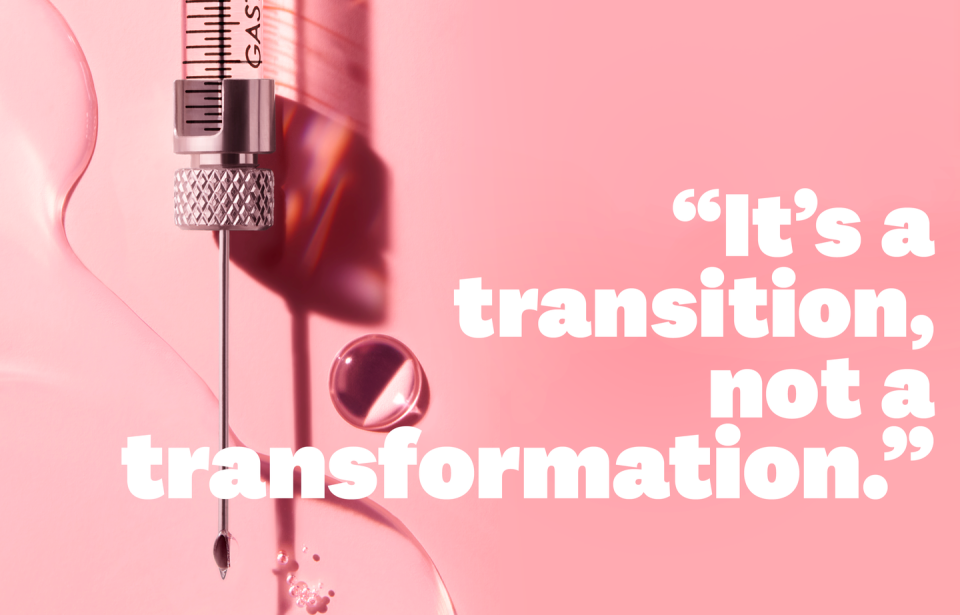Raise Your Hand If It Seems Like Everyone You Know Is Getting Botox Or Filler

Your computer screen is the new magnifying mirror. Only, you can’t just tuck your monitor in a drawer. After two years (and counting) of facing our digital reflections, the effects are playing out in real life, starting with a spike—at least anecdotally, for now—in people seeking injectables for the first time to address imperfections. “Staring at their face on the screen is a large part of what brings my cosmetic patients in,” says Los Angeles dermatologist Onyeka Obioha, MD. “They’re like, ‘I’m on Zoom all day, and this is what I notice.…’ ”
That’s exactly what led Deirdre Hering, 32, to get Botox last September. “After looking at my furrowing brow day in, day out, I realized that some lines remained, even when they were relaxed,” she says. She’s not alone, and hasn’t been for a while. The rate of botulinum-toxin injections among people ages 30 to 39 grew 35 percent from 2010 to 2018, according to the American Society of Plastic Surgeons. It’s true: Injectables are no longer the turf of Real Housewives and IG influencers.
But while going under the needle may be more common, it’s still a medical procedure—so it should be approached with the same careful consideration. From how to choose the right practitioner (note: they should definitely be a doctor) to when you should start (i.e., is preventive Botox actually a thing?), we’re here with facts.

Should you get a relaxer or a filler? Here's the difference.
For starters, all injectables are not equal. “A lot of people think that anything that comes out of a syringe is all the same,” says Melissa Kanchanapoomi Levin, MD, a dermatologist and founder of Entière Dermatology. Not true.
There are two categories of injectables: neuromodulators and fillers. Let’s start with neuromodulators, a.k.a. botulinum toxin, often referred to by the brand name Botox. These interfere with nerve communication, effectively relaxing the muscles, to soften lines and wrinkles created by repetitive muscle movement, such as lines between the brows caused by frowning, and crow’s-feet created by smiling.
While Botox isn’t the only neuromodulator out there, it’s the OG—in fact, it’s celebrating 20 years of FDA approval this month. (It’s also the only neuromodulator approved by the FDA to treat health conditions, like chronic migraine and excessive sweating.) The other FDA-approved neuromodulators all get to the same result, but with tiny differences along the way.
Dysport is thought to relax the muscles more quickly, whereas Xeomin is formulated without certain proteins, making it better for people with autoimmune diseases, says David Kim, MD, a cosmetic dermatologist at Idriss Dermatology: “Patients with autoimmune disease are more likely to form antibodies against these proteins.” (This doesn’t cause any harm; the ’tox may just not be as effective.)
Fillers, meanwhile, do exactly what the name says. “Filler is a substance that fills a hollowing, unlike Botox, which is going into the muscle,” says Dr. Obioha. While the exact substance in question can vary, the most common one is hyaluronic acid. “We use fillers for many different reasons, whether providing more structure for cheekbones, restoring fullness in the hollow areas under the eyes, or filling any sort of deep crevices or moderate-to-deep lines around the mouth,” says Dr. Levin. It can be used to plump the lips and add volume to the face too.
You might also hear about biostimulatory fillers that “activate your body’s natural machinery to make collagen,” says Dr. Levin. She prefers them to hyaluronic acid fillers, for the jawline and temples—or wherever people may need more fullness than a hyaluronic acid filler can give.
There’s a wide variety of brands to choose from; some, like Juvéderm Voluma, have more viscosity and are best for lifting, while others, such as Volbella, tend to be more fluid and are better for smoothing smaller areas, like around the lips. But as with the neuromodulators, it’s up to your chosen expert to determine the optimal one for you.
Who should you trust to administer injectables?
Finding the right injector is probably the most important factor in getting results you love. These days, it seems as if everyone from your dentist to your neighborhood spa is offering injectables, and many “pros” are being trained either online or during weekend courses.
But that’s super risky: If your provider doesn’t have the proper training, you can end up with results you hate, like a frozen face—or, absolute worst-case scenario, blindness. “It’s not enough that someone knows how to do the procedure,” says Dr. Levin. “Can they manage if things go wrong?”
So, where to start: “Seek care from a board-certified physician in the field of cosmetics,” says Dr. Obioha. “That’s dermatology, plastic surgery, ENT facial plastic surgery.” A provider you already trust is a good place to start. But know that simply going to a top pro doesn’t guarantee you’ll get the look you want.
Browsing before-and-after pics can help, but they can be edited. Better yet are referrals from friends and fam who have had Botox and were happy with the results.

When should you start getting injectables?
The “right” time to start any of these treatments depends mostly on the individual. (Forget that “once you’re 30” rule for Botox.) “If there’s nothing to treat, then leave it alone,” says Dr. Kim.
Your provider will assess that by having you make faces so they can see how expressive you are, since that can determine whether you could benefit from neuromodulators. “If the lines on those areas are exaggerated with movement, that’s a good time to go for a treatment,” he says.
Not very animated when you emote? “It behooves you to really focus on skin care instead,” says Dr. Levin. Basically, if it ain’t broke, don’t fix it just because you’re worried it might break in the future.
And no matter what, go slow at the start. Since you can’t always undo injectables, incremental tweaks make for the highest satisfaction—and prevent a big, not-so-subtle change that you might regret. “It’s always better to do a little bit, then bring the patient back two or three months later and see how they look, reassess, and come up with another plan based on [the first result],” says Dr. Kim. “It’s a transition, not a transformation.” Preach.
Are there side effects to getting injectables?
Side effects, where you at? Temporary redness and swelling are super common and should subside. For filler in particular, bruising is a biggie, along with swelling and lumps, says Dr. Obioha—the lumps being a clump of filler under the skin. While most go away on their own, any that don’t can be massaged out at a follow-up visit. (Just don’t DIY.)
You also have an optional rewind button with hyaluronic acid fillers thanks to hyaluronidase, an enzyme that can break down that acid, but that’s the only redo. If you got neuromodulators or biostimulatory fillers, they’re there until they dissolve on their own.
While most recovery is minor, getting injectables is a procedure and complications can happen. “Filler is particulate matter,” says Dr. Levin. “So if you’re getting into an artery, it can basically decrease or cut off blood flow to that area, which can cause tissue death and, in turn, permanent scarring.” That said, if you go to an experienced, properly trained provider, they’ll know how to handle it to keep you safe.

All Your Burning Questions, Answered
How soon do injectables start working?
Most fillers take effect right away. Neuromodulators’ magic happens in about 7 to 10 days, says Dr. Kim.Will they last long?
Neuromodulators last from three to six months, while filler can stick around for a year or more, depending on how fast your body metabolizes it. Exercise may be a factor, though current evidence is anecdotal. “Patients who exercise regularly will metabolize it 10 to 15 percent faster, in my experience,” says Dr. Kim. Since results of the science are still TBD, don’t forgo your sweat sessions just to keep your ’tox going a little longer (unless it’s the first day after your treatment—see top right).But do they hurt?
Neuromodulators are a quick pinch—and it’s easy to handle. Filler can be a little more gnarly, depending on pain tolerance. “I use topical numbing 20 minutes prior to the procedure, so that’ll ease the poke of the injection,” says Dr. Obioha. “After that, it becomes pretty tolerable.” Plus, filler has built-in numbing agents, so that also helps.Can you go for a run afterward?
Experts say: Skip it for at least 4 hours after Botox and at least 24 hours after filler. “Anything that increases blood pressure will increase the risk of bruising,” says Dr. Kim. (And for neuromodulators, you don’t want it to move around.) Hot tip: Plan your appointment around your rest day.So, how much does everything cost?
Fact: It doesn’t come cheap, with neuromodulators priced per unit (roughly $10 to $15) or based on the area of the face, depending on the practice; an average session is $466. Hyaluronic acid fillers clock in around $684 per syringe (anywhere from one to five could be needed). Biostimulatory fillers can run up to a couple hundred dollars more.Will insurance ever cover it?
Usually not for cosmetic reasons. But it could for medical conditions—chronic migraine and hyperhidrosis (excessive sweating), for example.This article appears in the April 2022 issue of Women’s Health. Become a Women’s Health+ member now.
You Might Also Like

